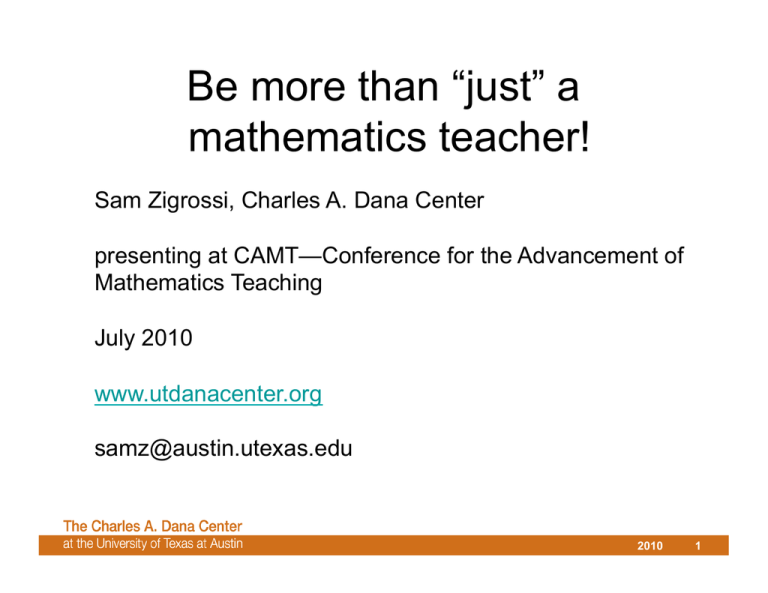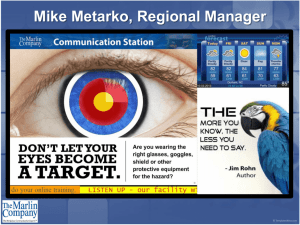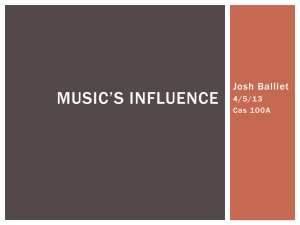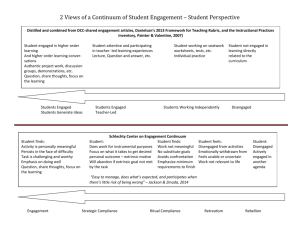Be more than “just” a mathematics teacher!
advertisement

Be more than “just” a mathematics teacher! Sam Zigrossi, Charles A. Dana Center presenting at CAMT—Conference for the Advancement of Mathematics Teaching July 2010 www.utdanacenter.org samz@austin.utexas.edu 2010 1 Be more than “just” a mathematics teacher! Agenda: • Get to know your students from various perspectives • Incorporate as much as possible the 21st-century skills • Clearly focus on STEM skills and knowledge • Incorporate the new Texas College and Career Readiness Standards into your instruction • Incorporate some career awareness into your instruction • Change perspectives on who you are and what you do. 2010 2 Get to know your students from various perspectives • What are students saying??? • Do you know? • If you are not asking them and discussing with them, then you are guessing. 2010 3 Gallup National Student Poll • 70,078 students in grades 5–12 took part • 335 schools in 59 districts across 18 states • Focus was on hope, engagement and well-being 2010 4 Gallup National Student Poll • Hope – The ideas and energy we have for the future; hope drives effort, academic achievement, credits earned, and retention of students – Hope items correlate positively with academic achievement and success after high school better than GPA or scores on ACT/SAT 2010 5 Gallup National Student Poll • Engagement – The involvement in and enthusiasm for school; engagement reflects how well students are known and how often they get to do what they do best. – Student engagement declines from grades 5 through 12 – Levels of engagement correlated to high and low performing schools 2010 6 Gallup National Student Poll • Well-being – How we think about and experience our lives; wellbeing tells us how students are doing today and predicts their success in the future 2010 7 Gallup National Student Poll Findings Hope • 50% of students polled are hopeful • 33% are stuck • 17% are discouraged • 95% believe they will graduate from high school 2010 8 Gallup National Student Poll Findings Engagement • 50% of students polled are engaged • 30% are not engaged • 20% are actively disengaged 2010 9 Gallup National Student Poll Findings Well-being • 63% of students polled are thriving • 36% are struggling • 1% are suffering 2010 10 Gallup National Student Poll Findings • 25% met the criteria of being hopeful, engaged, and thriving 2010 11 Gallup National Student Poll Findings • For the 50% who are hopeful, – 67% are engaged – 24% are not engaged – 9% are actively disengaged • For the 33% who are stuck – 40% are engaged – 38% are not engaged – 22% are actively disengaged 2010 12 Gallup National Student Poll Findings • For the 17% who are discouraged – 24% are engaged – 29% are not engaged – 47% are actively disengaged 2010 13 Gallup National Student Poll Findings • For the 63% who are thriving, – 58% are engaged – 28% are not engaged – 19% are actively disengaged • For the 36% who are struggling – 37% are engaged – 33% are not engaged – 30% are actively disengaged 2010 14 National Gallup Student Poll Findings • For the 1% who are struggling – 17% are engaged – 18% are not engaged – 65% are actively disengaged 2010 15 National Gallup Student Poll • What are the implications of these trends? • Consider participating www.gallupstudentpoll.com 2010 16 Lets look at some data that applies to about a third of Texas students and teachers Conducted by the International Center for Leadership in Education 2010 17 Teacher and student perspectives: comparison T—Students can apply what I am teaching to their everyday lives. 92% S—I can apply what I learn to my everyday life. 58% 18 Teacher and student perspectives: comparison T—Students in my classroom engage in hands-on activities. 88% S—We do lots of hands-on activities in my classes. 45% 19 Teacher and student perspectives: comparison T—I encourage students to explore career pathways. 80% S—My teachers encourage me to explore different careers. 49% 20 Teacher and student perspectives: comparison T—I make learning exciting for my students. 84% S—My teachers make learning exciting. 40% 21 Teacher and student perspectives: comparison T—I encourage students to use multiple resources when solving problems. 93% S—My teachers encourage me to use many resources to solve problems. 65% 22 Teacher and student perspectives: comparison T—I am aware of my students’ interests outside of school. 87% S—My teachers know my interests outside of school. 30% 23 Teacher and student perspectives: comparison T—I recognize students when they demonstrate positive behavior in school. 95% S—Good citizenship is rewarded in this school. 40% 24 Teacher and student perspectives: comparison T—I know my students’ academic interests and goals. 84% S—My teachers know my academic interests and goals. 35% 25 Teacher and student perspectives: comparison T—I know what my students are passionate about. 78% S—My teachers know what I love to do outside of school. 28% 26 How can you get to know your students better? Have students conduct the study, analyze it, and then participate in brief discussions— that you facilitate—on the results. 27 The 21st Century Skills Movement 2010 28 Focus on 21st Century Skills • Closer linkages and alignment of skills and knowledge acquisition in K–12 with what is needed for the workforce. • Why such a focus with high unemployment —aren’t there more people than jobs???? 2010 29 Focus on 21st Century Skills “Student Engagement: Focus on the Student!” by Leslie Wilson. Quotes the “2009 High School Survey of Student Engagement, Charting the Path from Engagement to Achievement,” which says that • Most high school students are bored and disconnected from school. These results have been consistent since 2006. Students from 103 high schools in 27 states participated in the survey. • Other interesting findings: – Less than half of students, 41%, said they went to school because of what they learned; – 23% reported that they went to school because they like their teachers; – 65% said they “like discussions in which there are no clear answers”; – 82% reported that they would welcome the chance to be creative in school. 2010 30 Focus on 21st Century Skills • In this high school survey, students clearly reported a desire to engage in dialogues where there are no clear answers and a desire for opportunities to engage their inventiveness in school. • Both these desires reflect the learners’ wishes for schools to call on their deeper thinking in collaborative settings and for the learners to get to tap their imaginative, innovative abilities. • Significant also is that nearly a quarter of respondents went to school because of relationships with their teachers. 2010 31 Focus on 21st Century Skills “Student Engagement: Focus on the Student!” by Leslie Wilson. Quotes the “2009 High School Survey of Student Engagement, Charting the Path from Engagement to Achievement.” • How do schools do this? How do they bring changes based on these findings to scale in their settings? • As a former high school principal: over a decade ago. we grappled with these matters and worked hard to create an environment where students became the focal part of all decisions and strategic planning. • We had the opportunity, through building a new high school facility, to wrap a physical and virtual structure around students’ needs, outcomes, programs, diversity, and future goals as citizens. 2010 32 Focus on 21st Century Skills Here is an overview of a few key components of what we did: • Integrated the latest systemic and personal technologies: laptops, technology laboratories for content areas, building-wide networks for teachers. • Created student-community gathering areas to support and enhance social, personal relatin. Incorporated the concepts and strategies for smaller learning communities (Klonsky et al., 2000) • Student–teacher advisors/mentors for four years • Aggressive and assertive plans for eliminating discrimination of all kinds, incorporating techniques to ensure acceptance, understanding, respect, and care for each person’s uniqueness, diversity, and well-being • Implementation of a 4x4 block schedule to increase instructional time, opportunities for uninterrupted cooperative projects, research and development of interpersonal relationships among students and between students and teachers. 2010 33 Focus on 21st Century Skills Here is an overview of a few key components of what we did: • Daily advisory periods for students/teachers to make personal connections that would lead to educational plans, goal setting, etc. • Integration of media center activities and resources through interschool networks. • Creation of large teaching and learning spaces to enhance project-based, collaborative work. 2010 34 21st Century Skills Focus http://www.guide2digitallearning.com/ blog_leslie_wilson/ student_engagement_focus_student 2010 35 Focus on 21st Century Skills The Partnership for 21st-Century Skills • The Partnership for 21st-Century Skills has emerged as the leading advocacy organization focused on infusing 21st-century skills into education. The organization brings together the business community, education leaders, and policymakers to define a powerful vision for 21st-century education to ensure every child's success as citizens and workers in the 21st century. • The Partnership encourages schools, districts and states to advocate for the infusion of 21st-century skills into education and provides tools and resources to help facilitate and drive change. The website is http://www.p21.org. 2010 36 STEM Focus From the 2010 Survey of science and STEM leaders conducted by IESD, Inc., in collaboration with STEM market expert Daylene Long: 1. Professional development was a funding priority for most STEM leaders and was perceived currently to be insufficient. 2. A majority of respondents projected an increase in technologydelivered STEM PD and a decrease in face-to-face STEM PD. 3. STEM leaders wanted technology tools that would support hands-on science. 4. Most STEM leaders thought that simulation software should be used in conjunction with hands-on activities rather than instead of such activities. 2010 37 STEM Focus From the 2010 Survey of science and STEM leaders conducted by IESD, Inc., in collaboration with STEM market expert Daylene Long: 5. A majority of STEM educators thought it was somewhat or very unlikely that eBook readers would be widely adopted in the next five years. The full report may be found here: www.sellingtoschools.com/products/ education-market-researchstem-education 2010 38 College Readiness Standards • A STAAR (State of Texas Assessments of Academic Readiness) focus area – College-readiness cutoff scores will be posted – Need cross curriculum collaboration Do you know about the results of the EOCs that students have taken so far????? 2010 39 Mathematics College Readiness Standards I. Numeric Reasoning (Number Sense) II. Algebraic Reasoning (Representations) III. Geometric Reasoning (Logic and Reasoning) IV. Measurement Reasoning (Measurement involving Statistics/Probability) V. Probabilistic Reasoning VI. Statistical Reasoning (Plan a study) VII. Functions (Model real world situations) VIII. Problem Solving (Real world problem solving) IX. Communication and Representation (Presentation and representation of mathematical work) X. Connections (Connections of mathematics to nature, real world situations and everyday life) 2010 40 Mathematics College Readiness Standards • What are the themes and areas that must be added to our curriculum to strengthen our students’ college readiness? 2010 41 Career Awareness 2010 42 Career Awareness • The 16 Career Clusters: http://www.careerclusters.org/16clusters.cfm • What jobs are growing and which are shrinking? • Implications for the future – Personal Financial Planning Model (Texas Scholars Program www.tbec.org) 2010 43 Change your perspectives on who you are and what you do? 2010 44 Change your perspectives on who you are and what you do? • Change your approach from teaching your students mathematics to teaching them to be mathematicians • What does this mean ? • Do you consider yourself a mathematician? 2010 45 Change your perspectives on who you are and what you do? • What do the college Readiness Standards focus on? Reasoning and critical thinking and communications. • Embed these into your student work • Have students research careers multiple times in a year with reports—with a focus on math • Have students develop problems for their peers 2010 46 Change your perspectives on who you are and what you do? • This approach supports what students are looking for in school—dialogue and discussion on issues where answers are not clear. • This approach supports the STEM areas and 21st century skills • And it can close the gap between student perceptions and teacher perceptions! 2010 47 Be more than “just” a mathematics teacher! • We need some movers and shakers out there working together to begin to make changes now, rather than putting it off for someone else to do later. • Become a a professional educator who will teach students to become mathematicians and help them to get ready for the real world. 2010 48 Other Resources The Partnership for 21st Century Skills, http://www.p21.org/index.php Gallup Student Poll, http://www.gallupstudentpoll.com/home.aspx TBEC Get There Texas, https://gettheretexas.com/?c=gettingStarted Common Core Standards, http://www.corestandards.org/ Understanding by Design, http://www.grantwiggins.org/ubd/ubd.lasso IBM Education Toolkit, http://www.reinventingeducation.org/RE3Web/ Edutopia (George Lucas Foundation), http://www.edutopia.org/ Career Pathways (Focus on Middle School), http://www.careerpathway.org/home.htm Mind Tools (Leadership Development), http://www.mindtools.com/pages/article/newTMC_5W.htm Student Perceptions, http://www.gifted.uconn.edu/siegle/SchoolPerceptions/printversion.pdf 49 Thank you for your participation! Sam Zigrossi samz@mail.utexas.edu 2010 50



